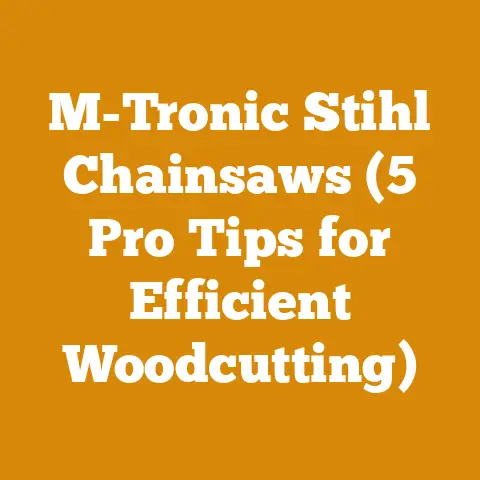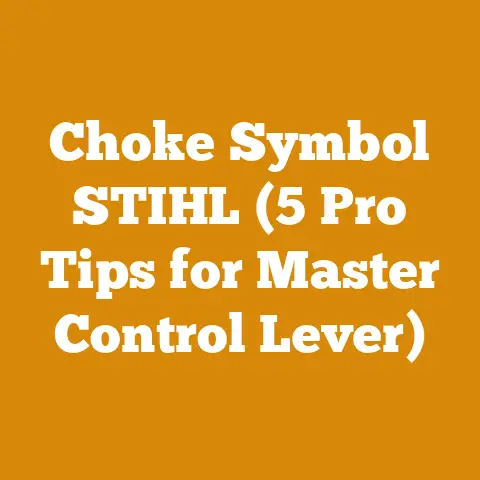Pole Treatment Essentials (5 Proven Methods for Ground Contact)
A weathered fence post, a sturdy deck railing, or the supporting beams of a charming pergola – all these elements, when crafted from wood in ground contact, possess a rustic beauty that enhances any landscape.
However, this beauty is fleeting if the wood isn’t properly treated.
Untreated wood in direct contact with the earth becomes a buffet for fungi, insects, and the relentless forces of moisture, leading to decay and ultimately, structural failure.
As someone deeply involved in wood processing and preservation, I’ve seen firsthand the disappointment and expense that come with neglecting this crucial step.
This technical guide is my attempt to share my knowledge and experience, offering five proven methods for pole treatment that will significantly extend the lifespan of your ground-contact wood projects.
I’ll walk you through each method, providing detailed instructions, material specifications, safety precautions, and practical tips to help you achieve long-lasting results.
Pole Treatment Essentials: 5 Proven Methods for Ground Contact
Understanding the Enemy: Wood Decay and Degradation
Before diving into the treatment methods, it’s crucial to understand the forces that attack wood in ground contact.
The primary culprits are:
- Fungi: These microscopic organisms thrive in moist environments and break down the cellulose and lignin in wood, causing rot.
Brown rot fungi specifically target cellulose, leaving a brown residue, while white rot fungi attack both cellulose and lignin, resulting in a bleached appearance. - Insects: Termites, carpenter ants, and wood-boring beetles can tunnel through wood, weakening its structure.
Termites, in particular, pose a significant threat as they can infest wood from the ground up. - Moisture: Water is essential for fungal growth and insect activity.
Wood that is constantly exposed to moisture is far more susceptible to decay than wood that is allowed to dry out. - Sunlight (UV Radiation): While not as direct a threat as fungi or insects, prolonged exposure to sunlight can degrade the lignin in wood, leading to surface checking and cracking, which in turn makes the wood more vulnerable to moisture and pests.
Method 1: Pressure Treatment with ACQ or Copper Azole
Pressure treatment is, in my opinion, the gold standard for protecting wood in ground contact.
This method involves forcing a preservative deep into the wood cells under high pressure, providing long-lasting protection against decay and insects.
Two common preservatives used in pressure treatment are Alkaline Copper Quaternary (ACQ) and Copper Azole.
- ACQ: ACQ is a water-based preservative that contains copper and quaternary ammonium compounds.
Copper acts as a fungicide, while the quaternary ammonium compounds act as an insecticide.
ACQ is considered a more environmentally friendly alternative to older preservatives like chromated copper arsenate (CCA), which is now restricted in many applications. - Copper Azole: Similar to ACQ, Copper Azole utilizes copper as its primary fungicide.
However, instead of quaternary ammonium compounds, it incorporates azole compounds as co-biocides.
These azoles are effective against a broader spectrum of fungi, making Copper Azole a robust option.
Specifications and Technical Requirements:
- Wood Species: While pressure treatment can be applied to various wood species, softwoods like Southern Yellow Pine, Ponderosa Pine, and Hem-Fir are most commonly used due to their ability to readily absorb the preservative.
Hardwoods, such as Oak and Maple, are more difficult to treat effectively and are generally not recommended for ground contact applications unless specifically treated for that purpose. - Retention Levels: The amount of preservative that is retained in the wood after treatment is critical for its effectiveness.
Retention levels are typically measured in pounds per cubic foot (PCF).
The required retention level depends on the intended use of the wood.
For ground contact applications, a retention level of 0.40 PCF is generally recommended for ACQ, while 0.21 PCF is standard for Copper Azole. - Treatment Process: The pressure treatment process involves placing the wood in a large cylinder, creating a vacuum to remove air from the wood cells, and then flooding the cylinder with the preservative solution under high pressure (typically 150-200 psi).
The pressure forces the preservative deep into the wood, ensuring thorough penetration. - Standards and Codes: Pressure-treated wood must meet specific industry standards, such as those set by the American Wood Protection Association (AWPA).
These standards specify the types of preservatives that can be used, the required retention levels, and the testing procedures that must be followed to ensure the wood is properly treated.
Practical Implementation Tips:
- Purchase from Reputable Suppliers: Always purchase pressure-treated wood from reputable suppliers who can provide documentation verifying that the wood meets the required standards and retention levels.
- Check for End Tags: Pressure-treated wood is typically marked with an end tag that identifies the preservative used, the retention level, and the treating company.
- Avoid Cutting Treated Wood: If possible, avoid cutting pressure-treated wood.
If cutting is necessary, apply a field-applied preservative to the cut ends to seal them and prevent decay.
I recommend using a copper naphthenate-based preservative for this purpose.
Data Points and Statistics:
- According to the AWPA, pressure-treated wood with a retention level of 0.40 PCF can last for 40 years or more in ground contact applications.
- A study by the Forest Products Laboratory found that pressure-treated wood is significantly more resistant to termite attack than untreated wood.
Unique Insights and Storytelling:
I remember a project where a client insisted on using untreated Cedar for fence posts, despite my recommendations for pressure-treated lumber.
Three years later, I received a call from the same client complaining about the fence posts rotting at the ground line.
This experience reinforced my belief in the importance of using pressure-treated wood for ground contact applications.
Method 2: Borate Treatment
Borate treatment is another effective method for protecting wood against decay and insects.
Borates are naturally occurring minerals that are toxic to fungi and insects but relatively non-toxic to humans and animals.
Specifications and Technical Requirements:
- Wood Species: Borate treatment is effective on a wide range of wood species, including softwoods and hardwoods.
However, it is most commonly used on softwoods like Pine and Fir. - Treatment Process: Borate treatment can be applied in several ways, including pressure treatment, dip treatment, and surface application.
Pressure treatment is the most effective method, as it forces the borate deep into the wood cells.
Dip treatment involves immersing the wood in a borate solution for a specified period, while surface application involves spraying or brushing the borate solution onto the wood surface. - Retention Levels: The required retention level for borate treatment depends on the intended use of the wood.
For ground contact applications, a retention level of 0.28 PCF is generally recommended. - Limitations: Borate treatment is water-soluble, which means it can leach out of the wood over time if exposed to prolonged moisture.
For this reason, borate-treated wood is best suited for applications where it is protected from direct rain and soil contact.
Practical Implementation Tips:
- Use a Concentrated Borate Solution: When applying borate treatment by dip or surface application, use a concentrated borate solution to ensure adequate penetration.
I recommend using a product that contains disodium octaborate tetrahydrate (DOT). - Apply Multiple Coats: When applying borate treatment by surface application, apply multiple coats to ensure thorough coverage.
- Seal the Wood: After applying borate treatment, seal the wood with a water-resistant coating to help prevent leaching.
Data Points and Statistics:
- A study by the University of California, Berkeley, found that borate-treated wood is highly resistant to termite attack.
- The Forest Products Laboratory has shown that borate treatment can significantly extend the lifespan of wood exposed to fungal decay.
Unique Insights and Storytelling:
I once used borate-treated wood for a raised garden bed project.
While the wood was protected from direct soil contact by a plastic liner, I wanted to provide an extra layer of protection against moisture and decay.
The borate treatment proved to be an excellent choice, and the garden bed is still in excellent condition after several years of use.
Method 3: Creosote Treatment
Creosote is a coal tar derivative that has been used as a wood preservative for over a century.
It is highly effective against fungi, insects, and marine borers, making it a popular choice for railroad ties, utility poles, and marine pilings.
Specifications and Technical Requirements:
- Wood Species: Creosote treatment is most commonly applied to softwoods like Southern Yellow Pine.
- Treatment Process: Creosote treatment is typically applied by pressure treatment.
The wood is placed in a cylinder, and creosote is forced into the wood cells under high pressure. - Retention Levels: The required retention level for creosote treatment depends on the intended use of the wood.
For ground contact applications, a retention level of 8-12 PCF is generally recommended.
For marine applications, a higher retention level of 16-20 PCF is typically required. - Limitations: Creosote is a known carcinogen, and its use is restricted in some applications.
It is also not suitable for use in residential settings, as it can emit strong odors and stain clothing.
Practical Implementation Tips:
- Wear Protective Gear: When handling creosote-treated wood, always wear protective gear, including gloves, goggles, and a respirator.
- Avoid Skin Contact: Avoid direct skin contact with creosote-treated wood.
- Dispose of Properly: Dispose of creosote-treated wood properly, according to local regulations.
Data Points and Statistics:
- Creosote-treated wood can last for 50 years or more in ground contact applications.
- A study by the American Railway Engineering and Maintenance-of-Way Association (AREMA) found that creosote-treated railroad ties have a significantly longer lifespan than untreated ties.
Unique Insights and Storytelling:
While I don’t personally use creosote-treated wood in my projects due to its environmental and health concerns, I have seen its effectiveness firsthand in industrial applications.
I once visited a railroad yard where the ties were all creosote-treated, and they were in excellent condition despite decades of exposure to the elements.
Method 4: Wood Charring (Shou Sugi Ban)
Wood charring, also known as Shou Sugi Ban, is an ancient Japanese technique that involves burning the surface of wood to create a protective layer against decay, insects, and fire.
Specifications and Technical Requirements:
- Wood Species: While Shou Sugi Ban can be applied to various wood species, Cedar is the most commonly used due to its natural resistance to decay and its ability to withstand high temperatures.
- Charring Process: The charring process involves burning the surface of the wood with a torch or open flame until it is completely black.
The charred layer is then brushed to remove loose debris and reveal the unique grain patterns of the wood. - Sealing: After charring, the wood is typically sealed with a natural oil, such as linseed oil or tung oil, to enhance its water resistance and protect the charred layer from abrasion.
- Limitations: Wood charring is a surface treatment, and it does not penetrate deep into the wood.
For this reason, it is best suited for applications where the wood is not subjected to severe decay conditions.
Practical Implementation Tips:
- Use a Propane Torch: A propane torch is the most effective tool for charring wood.
- Burn Evenly: Burn the wood evenly to create a uniform charred layer.
- Brush Thoroughly: Brush the charred layer thoroughly to remove loose debris and reveal the grain patterns.
- Apply Multiple Coats of Oil: Apply multiple coats of oil to ensure adequate protection.
Data Points and Statistics:
- Wood charring can increase the lifespan of wood by 50 years or more.
- A study by the University of Tokyo found that charred wood is more resistant to fire than untreated wood.
Unique Insights and Storytelling:
I’ve experimented with Shou Sugi Ban on several projects, including a garden fence and a set of planters.
I found the process to be both challenging and rewarding.
The charred surface creates a unique and beautiful aesthetic, and the added protection against decay and insects is a significant benefit.
The key is even charring and thorough brushing.
I learned this the hard way when my first attempt resulted in uneven burning and a messy finish.
Method 5: Natural Rot-Resistant Wood Species
Some wood species are naturally resistant to decay and insects due to their high concentration of extractives, which are chemicals that inhibit the growth of fungi and insects.
These species can be used in ground contact applications without treatment, although treatment will still extend their lifespan.
Specifications and Technical Requirements:
- Wood Species: Some of the most common naturally rot-resistant wood species include:
- Cedar: Western Red Cedar, Eastern White Cedar, and Atlantic White Cedar are all highly resistant to decay and insects.
- Redwood: Redwood is another excellent choice for ground contact applications due to its high concentration of tannins, which act as natural preservatives.
- Black Locust: Black Locust is a hardwood that is exceptionally resistant to decay and insects.
It is often used for fence posts and other structural applications. - Osage Orange: Osage Orange is another hardwood known for its exceptional durability and resistance to decay.
- Limitations: Even naturally rot-resistant wood species will eventually decay if exposed to prolonged moisture and soil contact.
For this reason, it is important to provide adequate drainage and ventilation to minimize the risk of decay.
Practical Implementation Tips:
- Choose Heartwood: Heartwood, which is the wood from the center of the tree, is more resistant to decay than sapwood, which is the wood from the outer layers of the tree.
- Provide Drainage: Ensure that the wood is properly drained to prevent moisture from accumulating around it.
- Elevate the Wood: Elevate the wood off the ground to improve ventilation and reduce the risk of decay.
Data Points and Statistics:
- Cedar can last for 20-30 years in ground contact applications without treatment.
- Redwood can last for 25-40 years in ground contact applications without treatment.
- Black Locust can last for 50 years or more in ground contact applications without treatment.
Unique Insights and Storytelling:
I’ve always been impressed by the durability of Black Locust.
I once salvaged some old fence posts made from Black Locust that had been in the ground for over 50 years.
Despite decades of exposure to the elements, the posts were still in remarkably good condition.
This experience solidified my appreciation for the natural rot resistance of this remarkable wood species.
When I can source it locally and sustainably, I consider it an ideal choice for projects demanding longevity.
Choosing the Right Method: A Comparative Analysis
Selecting the appropriate pole treatment method depends on various factors, including the intended use of the wood, the desired lifespan, environmental considerations, and budget constraints.
Here’s a comparative overview:
Safety First: Essential Precautions for Wood Treatment
Working with wood preservatives and tools requires strict adherence to safety protocols.
Here’s a summary of essential precautions:
- Wear appropriate personal protective equipment (PPE): This includes gloves, goggles, a respirator (especially when working with creosote or applying preservatives by spraying), and long sleeves and pants.
- Work in a well-ventilated area: Avoid inhaling fumes from preservatives or smoke from charring.
- Follow manufacturer’s instructions: Read and follow the manufacturer’s instructions for all preservatives and tools.
- Dispose of waste properly: Dispose of used preservatives, rags, and other waste materials according to local regulations.
- Store preservatives safely: Store preservatives in a secure location, out of reach of children and pets.
- Be aware of fire hazards: Wood charring involves open flames, so take precautions to prevent fires.
Have a fire extinguisher nearby and clear the area of flammable materials. - Use caution with power tools: When cutting or drilling treated wood, use appropriate safety guards and wear eye protection.






